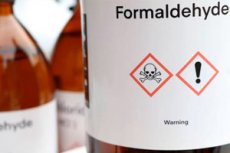FDA discusses banning formaldehyde in hair straightening products
最近審查:14.06.2024

The Food and Drug Administration (FDA) plans to ban the use of formaldehyde as an ingredient in chemical hair straightening products, also known as relaxers.
Teresa Werner, MD, associate director of the Huntsman Cancer Institute and professor of oncology at the University of Utah, and Crystal Lumpkins, PhD, MS, researcher at the Huntsman Cancer Institute and assistant professor at the University of Utah, discuss some important points.
“I believe this is an important step based on scientific research and data showing increased health risks, including cancer,” says Werner. “This ban emphasizes that we are constantly learning about risks and must be adaptive, using information to improve the health and safety of our patients.”
What is formaldehyde?
Formaldehyde is a colorless, flammable, and strong-smelling chemical best known for its use as an embalming fluid. The National Toxicology Program officially listed this substance as a known human carcinogen in 2011. According to the American Cancer Society, exposure to formaldehyde has been linked to cancer in both animals in laboratory studies and in humans.
But formaldehyde remained a common ingredient in relaxers. This is the first time the FDA has moved to ban the chemical from hair straighteners, though it has been under regulatory scrutiny for some time. The agency began warning relaxer users about possible formaldehyde exposure in 2010.
The FDA warns that formaldehyde in hair straighteners can be released into the air as a gas that can cause health problems if inhaled or comes into contact with the skin. Recent studies have also found possible long-term effects of chemical relaxers, particularly in uterine cancer.
In 2022, the National Institutes of Health found that women who use chemical relaxers have higher rates of uterine cancer than those who do not use them. The researchers found that 1.64 percent of women who never used hair straighteners would develop uterine cancer by age 70. For women who frequently used relaxers, that figure rose to 4.05 percent.
“That’s more than double, right? You might say, ‘Oh my gosh, that’s more than a 100 percent increase.’ But again, you have to consider that the risk of uterine cancer is very low overall, and there were fewer than 400 cases in the study,” Werner says. “So when you look at the absolute numbers, it’s not that big of an increase, but we’re always looking for factors that could potentially increase the risk.”
Women, Relaxers, and Uterine Cancer
Uterine cancer accounts for only 3 percent of all new cancer cases. But experts say rates are rising, especially among black women, who have twice the mortality rate for cervical cancer compared to other racial groups.
“We know that there are big health disparities based on race and ethnicity in cancer, and many black Americans use chemical relaxers,” Werner says. “It may not just be genetics, it may be other environmental factors for black women as they use these relaxers that may increase their risk of cancer.”
Chemical relaxers are marketed to black women to straighten their natural hair. According to a 2014 article in the Journal of Clinical and Aesthetic Dermatology, 60 percent of black women choose to have their hair chemically straightened. The practice usually begins at an early age — 46 percent of respondents reported having their hair chemically straightened for the first time between the ages of four and eight. Women can chemically straighten their hair for decades, visiting a stylist several times a year.
“It makes sense that such an environmental exposure would take a long time to actually cause cancer,” Werner says. “These women are older and they live longer. And the incidence of uterine cancer increases with age.”
This may be one reason why another long-term study, the Black Women's Health Study, also found statistically higher rates of uterine cancer among postmenopausal women.
Werner notes that the scalp is a highly vascularized area with vessels that carry blood and lymph throughout the body. "For some reason, uterine cells are more sensitive to substances that may be carcinogens," Werner says.
NIH researchers have identified formaldehyde as one of the ingredients that may contribute to an increased risk of cancer.
Hair and culture
For black women, the decision to use chemical relaxers is culturally sensitive, especially for older generations.
"There was an expectation that this was the way it was supposed to be, that you straighten your hair to make it look like other ethnic groups," Lumpkins says. “Straightened hair was seen as a sign of professionalism and beauty.”
Lumpkins notes that these social pressures complicate public health communication on this topic.
"There are people who have had straighteners burn their scalp, but they come back and do the procedure again," says Lumpkins. "The hair was falling out, but they said, 'I'll come back when the hair grows back and straighten it again.' This is not healthy.”
If the FDA decides to ban formaldehyde in relaxers, consumers will still have to consider other chemical risks when deciding whether to straighten their hair. For Lumpkins, this means continuing the conversation among black women, especially doctors and salon owners.
“It is important how to engage stakeholders in risk assessments that are culturally sensitive and appropriate. How can we be pragmatic and scientific about delivering information that is important and contributes to informed decision making?” - says Lumpkins.
“If there are products that do not use formaldehyde, if there is a safe alternative, then perhaps these relaxers are safe for women.”
Ultimately, people using chemical hair straighteners will need to make the best decision for their hair care and health needs.
“Black women’s hair is an important part of who they are,” Lumpkins says. “And it does impact a significant part of their lives, their health and well-being.”

